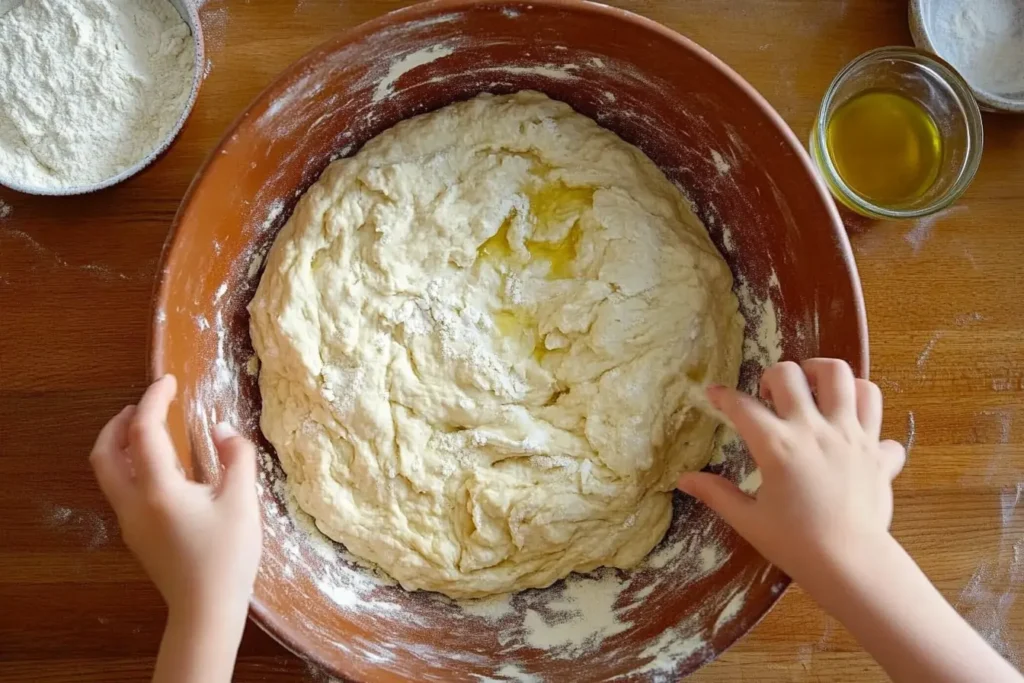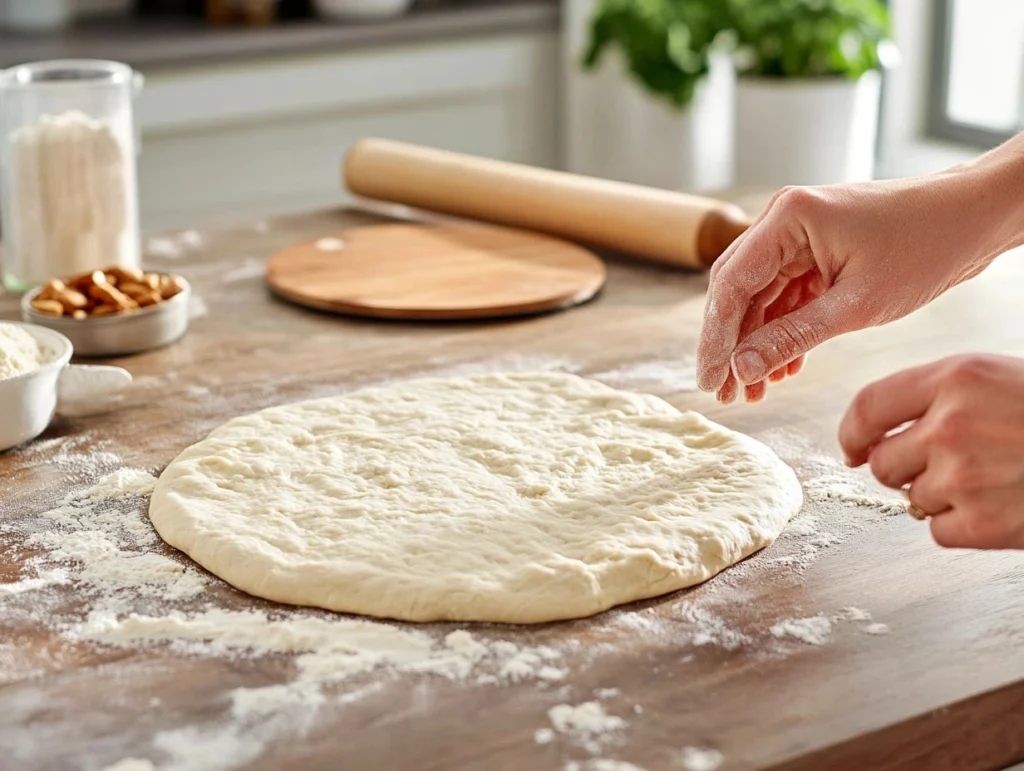Pizza night is even more exciting with this sourdough discard pizza dough recipe! If you’re looking for a way to reduce food waste while enjoying a tangy, artisan-style crust, this recipe is your answer. Crafted for both beginners and experienced bakers, this sourdough discard pizza dough recipe is a must-try for your next homemade pizza night. With easy steps and expert tips, you’ll achieve the perfect crust every time.
Not only is this recipe beginner-friendly, but it also offers flexibility to suit various tastes and dietary preferences. By following this detailed step-by-step process, you’ll learn how to handle dough like a pro, create a flavorful crust, and bake pizzas that your family and friends will rave about. So, let’s dive right in and explore everything you need to know about making this incredible pizza dough!
If you’ve been searching for the best way to use up leftover starter, this sourdough discard pizza dough recipe is your answer. It’s easy to make, reduces food waste, and results in a tangy, delicious crust that’s perfect for any homemade pizza night. This recipe has all the tips you need to ensure your sourdough discard pizza dough recipe turns out perfectly every time.
What is Sourdough Discard?
Before we jump into the recipe, it’s important to understand what sourdough discard is and why it’s such a valuable ingredient. Sourdough discard refers to the portion of starter that is removed before feeding the sourdough culture. This process helps maintain the right balance of yeast and bacteria in the starter while preventing it from becoming too large to manage. While some people throw this discard away, it can be a goldmine for creating tasty recipes.
Sourdough discard is the secret ingredient behind this easy-to-make sourdough discard pizza dough recipe. It’s the portion of sourdough starter removed before feeding, and it’s packed with flavor. Using discard in recipes helps reduce food waste and adds a tangy note to dishes. This sourdough discard pizza dough recipe transforms a humble ingredient into a mouthwatering crust.
If you’re looking for other ways to use sourdough discard creatively, don’t miss our Vegan Jalapeño Cheese Artisan Bread Recipe. It’s another great example of how discard can take your baking game to the next level.
Ingredients for the Perfect Dough
When it comes to making the perfect sourdough discard pizza dough, the ingredients play a crucial role. Each component has a specific function, and understanding this will help you achieve the ideal crust texture and flavor. Here’s what you’ll need for this recipe:
| Ingredient | Quantity |
|---|---|
| Sourdough discard | 1 cup (240g) |
| Bread flour | 2 ½ cups (320g) |
| Warm water | ½ cup (120ml) |
| Olive oil | 2 tbsp |
| Kosher salt | 1 tsp |
| Instant yeast (optional) | ½ tsp |
Ingredient Notes
The sourdough discard is the star of this recipe, providing a tangy flavor and helping the dough rise naturally. Bread flour is recommended for its high protein content, which contributes to the chewy texture of the crust. However, you can also substitute all-purpose flour or even whole wheat flour if desired. Adding a touch of olive oil helps make the dough more pliable and enhances its richness. Kosher salt is used to bring out the flavors, and a pinch of instant yeast can be added if you want a quicker rise time.
For those who love experimenting with baking, check out our Greek Yogurt Garlic Breadsticks Recipe for another delightful way to play with dough.
To achieve the best results with your sourdough discard pizza dough recipe, it’s important to use the right ingredients. Each component in this recipe plays a key role in creating a crust that’s tangy, crispy, and irresistible.

Step-by-Step Instructions
Begin this sourdough discard pizza dough recipe by mixing your sourdough discard with warm water and olive oil. This is the foundation of a flavorful and elastic dough. The sourdough discard pizza dough recipe shines when you use techniques like stretching and folding, which build the gluten structure for an artisan-style crust.
This section provides a detailed guide to making your sourdough discard pizza dough recipe with ease. From mixing the dough to stretching it into the perfect shape, every step ensures a flawless crust.
1. Mixing the Dough
Begin by combining your sourdough discard, warm water, and olive oil in a large mixing bowl. Stir until the mixture is smooth and well-blended. Next, add the bread flour and kosher salt. If you’re using instant yeast for a faster rise, sprinkle it over the flour before mixing. Stir until a shaggy dough forms, ensuring all the flour is incorporated.
If the dough feels too dry, don’t hesitate to add a tablespoon of water at a time until you reach the right consistency. Conversely, if the dough is too sticky, dust it lightly with additional flour.
2. Stretch and Fold Technique
To develop the dough’s gluten structure without kneading, use the stretch-and-fold method. Start by grabbing one edge of the dough, stretching it upward, and folding it back onto itself. Rotate the bowl 90 degrees and repeat this process four to six times. Let the dough rest for about 30 minutes between each set of folds. This method helps create a strong gluten network, which is essential for a chewy and elastic crust.
Using this technique also helps trap air bubbles in the dough, which will later translate to a beautifully airy pizza crust.
3. First Rise (Bulk Fermentation)
After completing the stretch-and-fold process, cover the bowl with a damp towel or plastic wrap and let the dough rise at room temperature for two to three hours. The dough should double in size and feel light and puffy. This step allows the natural fermentation to develop the dough’s flavor and texture.
If your kitchen is on the cooler side, consider placing the bowl near a warm spot, such as on top of your refrigerator or next to a preheated oven.

4. Shaping the Dough
Once the dough has risen, transfer it onto a floured surface and divide it into two equal portions. Gently shape each portion into a round ball, being careful not to deflate the dough. When you’re ready to stretch it out, use your hands to gently pull the dough into a 10- to 12-inch circle. Avoid using a rolling pin, as it can crush the air pockets that give the crust its light texture.
5. Baking the Pizza
Preheat your oven to 500°F (260°C) and place a pizza stone or steel inside to heat for at least 30 minutes. If you don’t have a pizza stone, an upside-down baking sheet works well too. Transfer the shaped dough onto a piece of parchment paper or a floured pizza peel, add your desired toppings, and slide it onto the hot stone. Bake for 7–10 minutes, or until the crust is golden and bubbly.
Expert Tips for Success
Success in making sourdough discard pizza dough often comes down to the details. First, always use a kitchen scale for accurate measurements. Precision is key, especially when working with sticky dough. Additionally, preheating your oven and pizza stone is essential for achieving a crispy crust. For more tips and tricks, explore our Pickle Pie Pizza Guide, where we share unique ideas for making pizza night extra special.
Toppings and Flavor Ideas
Pizza is all about creativity, and this sourdough crust provides the perfect canvas. Here are some ideas to inspire your next pizza night:
- Classic Margherita: Tomato sauce, fresh mozzarella, and basil.
- Mediterranean Veggie: Hummus base, roasted red peppers, olives, and feta cheese.
- Buffalo Chicken: Shredded chicken, buffalo sauce, and blue cheese crumbles.
- Breakfast Pizza: Scrambled eggs, bacon, and cheddar cheese.
Storage and Freezing Options
If you’d like to make the dough in advance, it’s easy to store. For short-term storage, place the dough in an airtight container and refrigerate for up to three days. For longer storage, wrap individual dough portions in plastic wrap and freeze for up to three months. When ready to use, thaw the dough in the fridge overnight and allow it to come to room temperature before shaping.
Why Use Sourdough Discard?
Incorporating sourdough discard into your recipes not only reduces food waste but also opens up a world of culinary possibilities. This ingredient is versatile and adds a tangy depth of flavor that’s hard to replicate with other methods. Plus, it’s an eco-friendly way to get the most out of your sourdough starter.
The star of this sourdough discard pizza dough recipe is the discard itself. Using this ingredient minimizes food waste while delivering a distinct tangy flavor to your pizza crust. This eco-friendly, flavor-packed option is perfect for anyone who loves experimenting in the kitchen.
Variations of Sourdough Discard Pizza Dough
One of the best things about this sourdough discard pizza dough recipe is its versatility. You can adapt it to suit different preferences, dietary needs, and occasions. Here are a few popular variations to try:
1. Thick-Crust Pizza Dough
If you prefer a heartier, fluffier crust, allow the shaped dough to proof for an additional 30–45 minutes before baking. This extra rise time will create a thicker, more pillowy texture. Pair this crust with robust toppings like sausage, caramelized onions, and mozzarella for a comforting meal.
2. Whole Wheat Pizza Dough
For a more nutritious option, replace up to 50% of the bread flour with whole wheat flour. This substitution adds a nutty flavor and boosts the fiber content of your crust. Be aware that whole wheat dough tends to absorb more water, so adjust the hydration as needed by adding a splash of warm water during mixing.
3. Gluten-Free Variation
Although this recipe relies on the structure provided by gluten, you can experiment with gluten-free flour blends designed for bread baking. Be sure to choose a sourdough discard that was started with gluten-free ingredients to keep the recipe suitable for dietary restrictions.
4. Vegan-Friendly Dough
This dough is naturally vegan, as it doesn’t contain any dairy or eggs. Top it with dairy-free cheeses and an assortment of fresh vegetables to create a vegan pizza that doesn’t compromise on flavor.
For more unique dough and bread recipes, check out our How to Bake Authentic Anise Cookies for inspiration.
Why Use a Pizza Stone for Baking?
A pizza stone or steel is a secret weapon for achieving a perfectly crispy crust. These tools mimic the intense heat of a professional pizza oven, ensuring even baking and better crust texture. To use a pizza stone effectively, place it in your oven during preheating and let it absorb as much heat as possible (at least 30 minutes). Then, slide your pizza onto the hot stone using a peel or parchment paper for best results.
If you don’t own a pizza stone, an upside-down baking sheet can provide a similar effect. It’s not quite as efficient, but it’s a great alternative for home cooks.
How to Troubleshoot Common Issues
Even with the best intentions, pizza dough can sometimes be a bit tricky. Here are solutions to common challenges:
- Sticky Dough: Dust your hands and work surface with flour. If it’s persistently sticky, let the dough rest for 10 minutes before handling it again.
- Dense Crust: This can happen if the dough hasn’t proofed long enough. Make sure it doubles in size during the first rise.
- Burned Crust: Reduce the baking temperature slightly or use a lower oven rack. Keep an eye on your pizza after 7 minutes of baking.
- Dough Tearing During Shaping: Be gentle when stretching the dough, and let it rest for 5–10 minutes if it resists. This allows the gluten to relax.

Creative Topping Combinations
When it comes to toppings, the possibilities are endless. While classics like Margherita and pepperoni will always have a place at the table, why not get creative with some adventurous combinations?
- Caprese-Inspired Pizza: Fresh mozzarella, cherry tomatoes, basil, and a drizzle of balsamic glaze.
- Spicy Buffalo Chicken: Shredded chicken tossed in buffalo sauce, red onions, and blue cheese.
- Fig and Prosciutto: Sliced figs, thinly sliced prosciutto, arugula, and a touch of honey.
- Breakfast Pizza: Scrambled eggs, cooked bacon or sausage, and shredded cheddar cheese.
Feel free to experiment with seasonal ingredients or leftovers from your fridge. Pizza is a great way to reduce waste and get creative in the kitchen.
FAQs Section
1. How do I share my sourdough pizza recipe online?
Sharing your sourdough pizza recipe online is simple! Start by writing a detailed blog post or social media caption that includes step-by-step instructions, ingredient lists, and any personal tips or anecdotes. Use high-quality photos or videos of the preparation and final result to make your content visually engaging. To optimize your post for search engines, include relevant keywords like “sourdough discard pizza dough recipe” and tag it with related topics. Sharing your recipe on platforms like Pinterest or Instagram can also help it reach a wider audience of food enthusiasts.
2. What other types of sourdough bread can I make?
Sourdough discard and starter can be used to make a variety of bread beyond pizza dough. Here are some ideas:
- Artisan Sourdough Boule: A crusty, rustic loaf perfect for soups and sandwiches.
- Sourdough Focaccia: Topped with olive oil, herbs, and flaky sea salt.
- Sourdough Bagels: Chewy and delicious, with endless topping options.
- Sourdough Pretzels: Soft and salty, ideal for snacks.
- Sourdough Pancakes: A breakfast favorite with a tangy twist.
Explore our Vegan Jalapeño Cheese Artisan Bread Recipe for more inspiration.
3. What are some unique sourdough pizza topping combinations?
While classic pizza toppings are always a hit, sourdough pizza is a perfect base for creative combinations. Try these unique options:
- Sweet and Savory: Pear slices, gorgonzola cheese, and toasted walnuts.
- Mediterranean: Roasted eggplant, sun-dried tomatoes, and crumbled feta.
- Spicy and Smoky: Chorizo, smoked gouda, and pickled jalapeños.
- Brunch Pizza: Sautéed spinach, soft-cooked eggs, and hollandaise drizzle.
- Dessert Pizza: Nutella, fresh strawberries, and powdered sugar.
For more ideas, check out our Pickle Pie Pizza Guide.
4. What are other sourdough bread recipes?
There’s a whole world of sourdough recipes waiting to be explored. In addition to traditional loaves, here are a few to try:
- Sourdough English Muffins: Perfect for breakfast sandwiches.
- Sourdough Crackers: Thin and crispy, ideal for charcuterie boards.
- Sourdough Cinnamon Rolls: Sweet and tangy with a soft, fluffy texture.
- Sourdough Naan: A soft, chewy flatbread for curries or wraps.
- Sourdough Biscuits: Buttery and flaky, perfect for brunch or dinner.

Conclusion
This sourdough discard pizza dough recipe is a must-try for anyone who loves the idea of combining sustainability with deliciousness. Whether you’re planning a family pizza night, impressing friends, or just exploring new recipes, this dough is the perfect starting point for endless culinary creativity. With its unique flavor, easy preparation, and adaptability, it’s no wonder that sourdough discard pizza dough has become a favorite among home cooks and baking enthusiasts alike.

